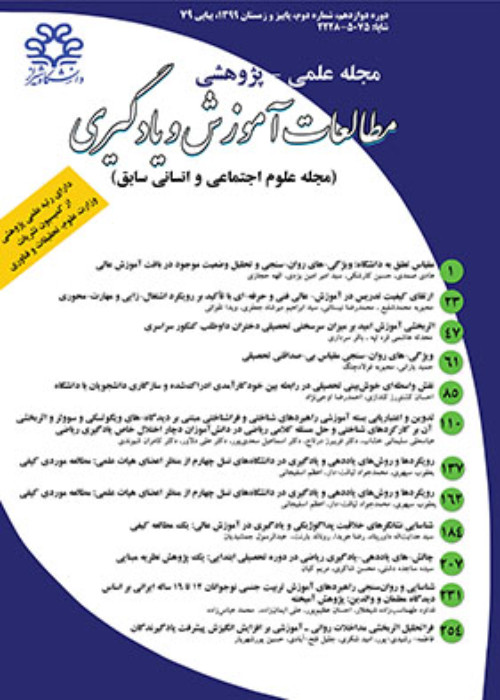The Effect of Teaching Creativity on the Cognitive Aspects of High School Student's Creativity: A Report of Seasonal Creativity and Idea Schools of Fars Province
Author(s):
Article Type:
Research/Original Article (دارای رتبه معتبر)
Abstract:
Introduction
To handle challenges in their lives, human beings need to be creative. Due to the important role of creativity in human life, many scholars (e.g., de Bono, 1986; Guliford, 1967, Torrance, 1990) started to conduct studies to investigate different aspects of creativity. Hence, new perspectives are constantly added to creativity and the way one can enhance it. The present study was an attempt to investigate the effect of teaching creativity on high school students cognitive related aspects of creativity including observation ability, thinking ability, data analysis, coherent thinking, identification of in-text relationships, and using schemata. This study was an investigation to answer the following research questions:Research Questions1. Does teaching creativity to high school students have any significant effect on the cognitive-related aspects of their creativity when doing the project based tasks individually?
2. Is there any statistically significant deference between females and males when doing the project-based tasks individually?
3. Does teaching creativity to high school students have any significant effect on the cognitive-related aspects of their creativity when doing the project based tasks individually?
4. Is there any statistically significant deference between females and males when doing the project-based tasks collaboratively?
Method
Participants in this study were 73 students high school students (33 females and 40 males) with 14 to 16 years of age, who were selected through purposive sampling according to whether they had previously attended any extracurricular activities held at school. These students had enrolled in the seasonal school of creativity held by Fars Elite Foundation, whose purpose is to increase the students creativity. In these workshops, the students generally learn how to observe the environment around themselves, how to detect problems, how to brainstorm for the problems, and how to evaluate their ideas to select one as a solution to the observed problem. The study used the one-group, pre-test post-test design in which the researchers assessed the creativity of the students before and after the instructions through task-based assessment. The pretest was a project-based task examining the students level of creativity with regard to the cognitive aspects of creativity, including the ability to observe, analyze data, think coherently, identify in-text relationships, and use schemata. Following that, the workshops started and the students took part in different workshops. At the end of the program, a post-test was administered in which the students were asked to provide their responses to another project-based task examining the aforementioned factors. A scale was designed to assess the tasks based on the stated criteria. Two raters assessed the responses provided by the students through the given rating scale. To reduce misunderstandings, the two raters practiced using the scale before they applied it to evaluate the tasks. Using Cramer Correlation Coefficient, interrater reliability was assessed between the two raters. With r = .82, the results suggested a high degree of agreement based on Cohen (1998).Results
The results revealed that the creativity instruction had a statistically significant effect on the cognitive aspects of both male and female students, no matter whether they accomplished the tasks individually or collaboratively. That said, the results indicated that all of the six factors including observation ability, thinking ability, data analysis, coherent thinking, identification of in-text relationship, and using schemata increased more significantly for female students in the post-test, especially when they performed on the tasks individually. However, coherent thinking of the boys did not show any statistically significant differences in the post-test when they did the tasks individually. Moreover, no statistically significant difference was seen in the collaborative performance between female and male students while doing the tasks.Discussion
There are different reasons for the obtained information. First of all, based on Schmidts (2010) awareness hypothesis, one can argue that when students participated in the workshops with thinking and creativity essence, they became aware of creativity and thinking strategies, which they applied in the post-test task. On top of this, the hands on policy used to instruct the students might have helped them to enhance their criticality in thinking and creativity. Finally, the syllabus design of the seasonal schools of creativity and ideation might have contributed to the students enhanced creativity when performing on the second tasks. This could be insightful for the instruction of creativity. The findings bear some implications for teaching and promoting creativity in high school students.Keywords:
Language:
Persian
Published:
Studies in Learning & Instruction, Volume:10 Issue: 1, 2018
Pages:
206 to 229
magiran.com/p1879785
دانلود و مطالعه متن این مقاله با یکی از روشهای زیر امکان پذیر است:
اشتراک شخصی
با عضویت و پرداخت آنلاین حق اشتراک یکساله به مبلغ 1,390,000ريال میتوانید 70 عنوان مطلب دانلود کنید!
اشتراک سازمانی
به کتابخانه دانشگاه یا محل کار خود پیشنهاد کنید تا اشتراک سازمانی این پایگاه را برای دسترسی نامحدود همه کاربران به متن مطالب تهیه نمایند!
توجه!
- حق عضویت دریافتی صرف حمایت از نشریات عضو و نگهداری، تکمیل و توسعه مگیران میشود.
- پرداخت حق اشتراک و دانلود مقالات اجازه بازنشر آن در سایر رسانههای چاپی و دیجیتال را به کاربر نمیدهد.
In order to view content subscription is required
Personal subscription
Subscribe magiran.com for 70 € euros via PayPal and download 70 articles during a year.
Organization subscription
Please contact us to subscribe your university or library for unlimited access!


